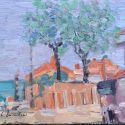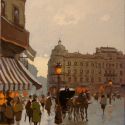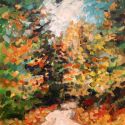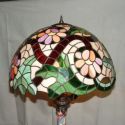The US-born painter and printmaker Lyonel Feininger had a career unlike that of any other US artist of his generation–the first generation of US modernists that included Alfred Maurer (born 1868), John Marin (born 1870) and Marsden Hartley (born 1877), all of whom Feininger outlived. Feininger was himself born in New York into a German-American musical family and study music (violin and composition) that he went off to Germany at the age of 16. It wasn’t until half a century later–in 1937, when his paintings were included in the infamous Degenerate Art exhibition in Munich–that he quit Germany for good and re-established himself in the city of his birth.
Before he was known as a modern painter, however, Feininger had achieved considerable success as a caricaturist and cartoonist, drawing political cartoons for German newspapers and then a well-known comic strip for the Chicago Tribune. It was his contract with the Tribune that enabled him to spend two years in Paris (1906-08), where the influence of Cubism and Futurism–especially the Orphic Cubism of Robert Delaunay–became the basis of his later work as a painter on both sides of the Atlantic.
After the artist’s early work, comes the period in which elements of caricature and folklore are gradually but decisively supplanted by Cubist form and the aesthetics of abstraction. For reasons beyond the artist’s control, much of his early work as a painter remained unknown in the US until the mid-1980’s. For it was only then–and after considerable legal wrangling–that the Feininger estate was able to retrieve the large quantity of Feininger’s early oeuvre that he left in the safekeeping of a German friend when the artist and his wife, Jewish, fled Nazi Germany for New York in 1937. That important body of work was shown for the first time in the US in 1985. One of these paintings is The Carnival in Gelmeroda (1908). Feininger’s principal motif in the painting–the church in the center of the village of Gelmeroda–was subsequently transformed into the language of Cubism. Feininger often returned to this motif in the years that followed the completion of the Carnival painting, these drawings give us a detailed account of his development in this crucial period of his work.
Feininger was an artist of far more versatile talents than he is usually given credit for. His is, after all, one of the few 20th-century oeuvres in which the modernist movements in Germany, France and the United States live on remarkably easy terms with each other. In Paris, he was on friendly terms with Delaunay; at the Bauhaus, he was close to Klee and Kandinsky (though he loathed László Moholy-Nagy and lamented his influence); and in the United States, he developed an important friendship with Mark Tobey, with whom he carried on an extensive correspondence. The young artist who entertained newspaper readers in Germany and the U.S. with political cartoons and comic strips was also the man who created the signature image — the woodcut of the so-called Cathedral of Socialism — for Walter Gropius’ first Bauhaus manifesto. Still later, after his return to New York, he created a memorable series of mystical Cubist paintings of Manhattan skyscrapers–paintings in which the vertical cityscape, newly discovered after half a century abroad, is depicted in highly poetic crystalline structures of light. They remain some of the most beautiful paintings ever inspired by the Manhattan skyline.
inchide 
Newsletter
Stay tuned with arts. Subscribe to Artline art news send directly to your mailbox by artLine.ro

































